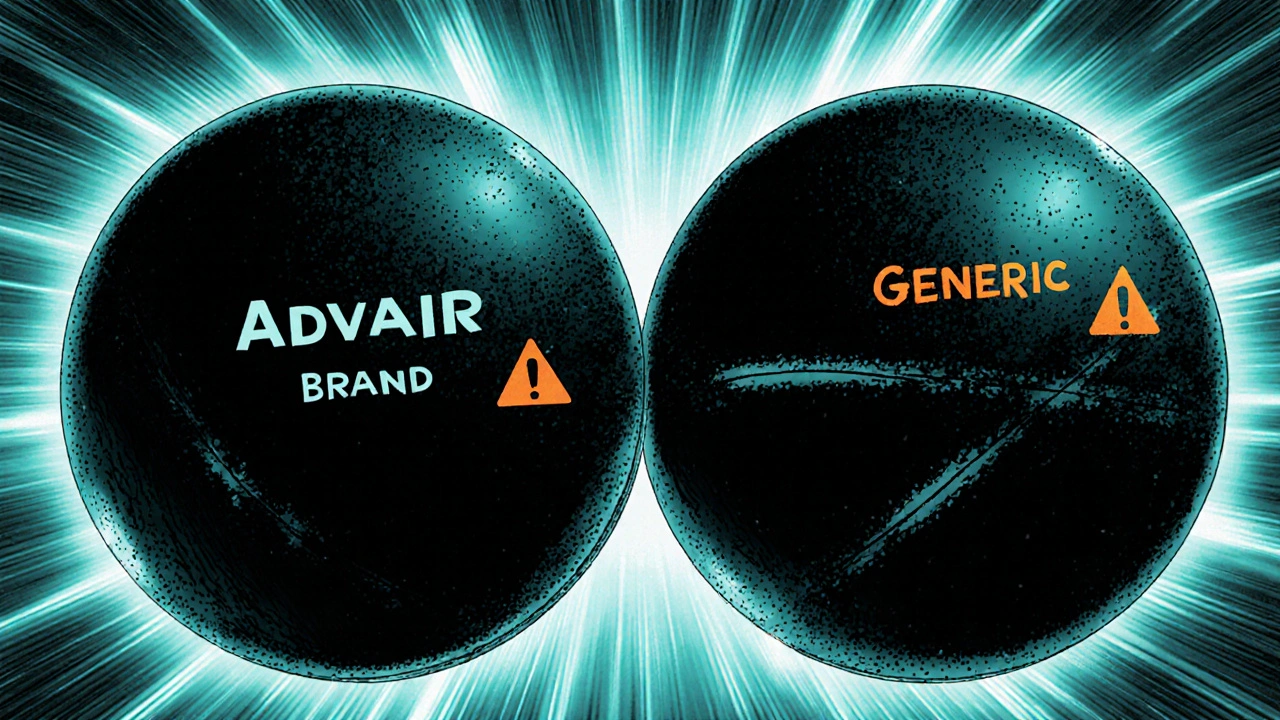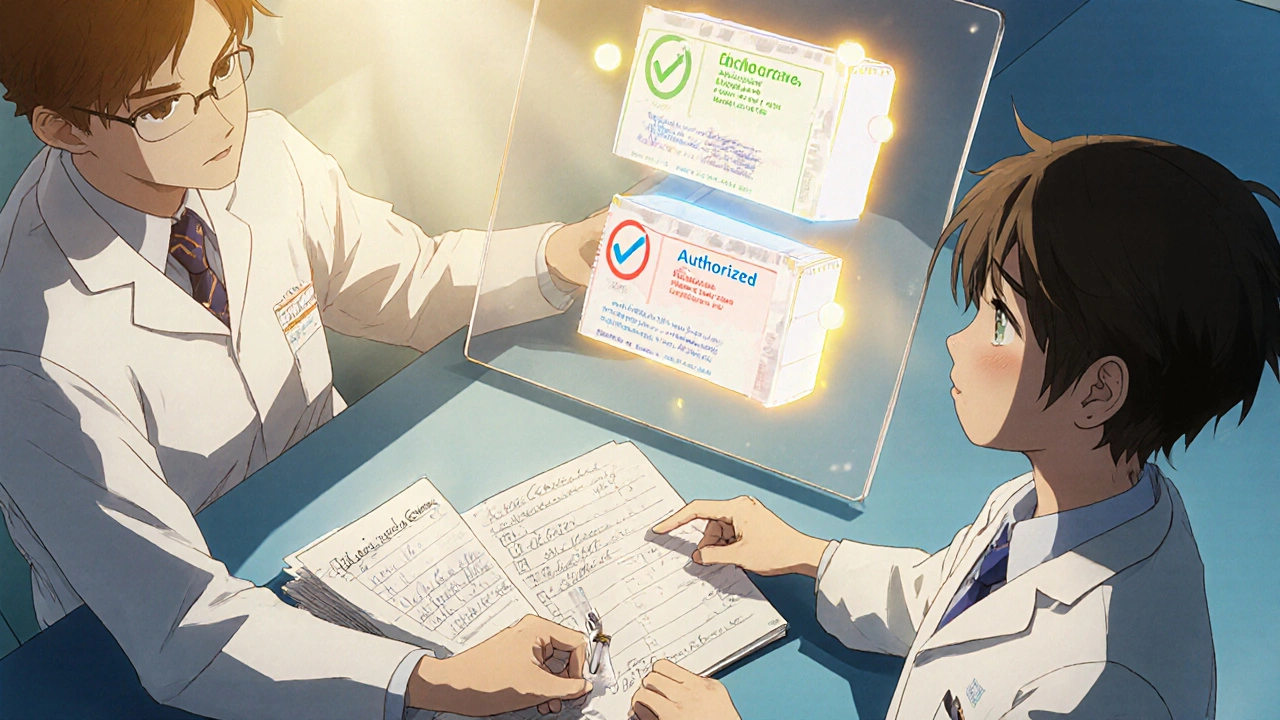
Most people assume that if a generic drug has the same active ingredients as the brand name, it will work the same way. That’s usually true-but not always. When it comes to combination medications, where two or more drugs are packed into one pill or inhaler, even small differences in inactive ingredients can cause real problems for some patients. These aren’t just theoretical concerns. People are reporting side effects, reduced effectiveness, and even hospital visits after switching from a brand-name combo drug to a generic version.
Why Generic Combinations Aren’t Always Identical
The FDA requires generic drugs to contain the same active ingredients in the same strength as the brand name. That part is non-negotiable. But when it comes to everything else-fillers, binders, coatings, dyes, preservatives-manufacturers have freedom. These are called inactive ingredients, and they play a bigger role than most people realize. For example, a generic version of Advair Diskus (fluticasone/salmeterol) might use a different type of lactose or magnesium stearate than the brand. Sounds harmless, right? But in inhalers, those differences can change how the drug is delivered to the lungs. A 2021 study found that some generic inhalers deposited 15-20% less medication into the lungs compared to the brand. That’s not a small gap-it’s enough to make someone reach for their rescue inhaler more often. The same issue shows up in pills. Metformin/sitagliptin, a common combo for type 2 diabetes, has had reports of increased stomach upset in generic versions. Patients didn’t have those issues with the brand, but after switching, they started experiencing nausea and bloating. In many cases, the active ingredients were identical. The problem? A different binder or coating changed how quickly the drug dissolved in the gut.Who’s Most at Risk?
Not everyone will notice a difference. For most people, generics work just fine. But certain groups are more vulnerable:- Narrow therapeutic index (NTI) drug users: These are medications where even tiny changes in blood levels can cause harm. Examples include warfarin, levothyroxine, and some seizure drugs. A 2020 study of 89,000 Medicare patients switching from brand to generic levothyroxine found that 12.3% needed a dosage adjustment because their thyroid levels changed.
- Elderly patients with multiple conditions: Older adults often take five or more medications. Small changes in how one drug is absorbed can throw off the whole balance.
- People with allergies or sensitivities: Some generics use different dyes or preservatives. One patient reported a rash after switching to a generic version of a combo blood pressure pill-turns out, the generic used a dye the brand didn’t.
- Patients on psychiatric or endocrine meds: A PatientsLikeMe analysis showed 31% of users reported issues after switching generic psychiatric combos, and 29% had problems with thyroid or diabetes combos.
What the Data Shows
The numbers tell a clear story:- 90% of U.S. prescriptions are filled with generics-many of them combinations.
- Generic combo drugs cost 85% less than brand versions, saving Medicare $1.67 trillion between 2006 and 2019.
- But 47% of generic combinations have different inactive ingredients than their brand counterparts, according to a 2017 study.
- 23% of patients switching from Advair Diskus to a generic reported increased rescue inhaler use within 90 days.
- 34% of independent pharmacists say they’ve received patient complaints about generic combo substitutions.

Authorized Generics: The Middle Ground
There’s a version of generic that’s actually identical to the brand: the authorized generic. These are made by the same company that makes the brand name, just sold under a different label. For example, Pfizer makes an authorized generic of Lyrica (pregabalin) that has the exact same ingredients, coating, and manufacturing process. The catch? Authorized generics cost 15-20% more than standard generics. But they’re still 60-70% cheaper than the brand. For patients who’ve had bad reactions to regular generics, this can be a lifesaver. The problem? Many pharmacies don’t stock them unless specifically requested. And insurance often won’t cover them without prior authorization.What Pharmacists Should Do
Pharmacists aren’t just filling prescriptions-they’re gatekeepers. The USP Chapter <1099> guidelines recommend a five-step check before substituting a generic combo:- Therapeutic index: Is this a narrow therapeutic index drug? If yes, proceed with caution.
- Patient history: Has the patient ever had issues with generics before? Did they report side effects after switching?
- Bioequivalence data: Check the FDA’s Orange Book for therapeutic equivalence ratings. An ‘A’ rating means generally safe. A ‘B’ means potential concerns.
- Allergies: Does the patient have known sensitivities to lactose, dyes, or preservatives? The generic might contain one they can’t tolerate.
- Disease stability: Is the patient’s condition well-controlled? Switching during an unstable period increases risk.

What Patients Can Do
You don’t have to accept a switch blindly. Here’s what you can do:- Ask your pharmacist: “Is this the brand or a generic? If it’s generic, what’s the manufacturer?”
- Check the pill’s imprint code. Different manufacturers use different shapes and colors-even if the drug is the same.
- Keep a symptom journal. Note any new side effects or changes in effectiveness after a switch.
- Ask your doctor to write “Dispense as Written” or “Do Not Substitute” on the prescription. This legally prevents the pharmacy from switching without your consent.
- Request the authorized generic if you’ve had problems before. It’s often available, even if it’s not the default option.
The Bigger Picture
The push for generics is understandable. They save billions. But the system was built for simple, single-drug generics. Combination products are more complex. Their delivery systems-whether it’s an inhaler, a patch, or a slow-release tablet-depend heavily on inactive ingredients. The FDA is starting to catch up. In 2023, they required Teva’s generic Advair to pass the same inhaler performance tests as the brand. That’s a big step. New rules coming in 2024 will require manufacturers to report adverse events linked to formulation differences. And by 2025, the industry plans to list all inactive ingredients on generic labels-something they’ve avoided for decades. Until then, the burden falls on patients and providers. Generic drugs are a win for most people. But for some, they’re a gamble. Knowing when to question a switch-and how to protect yourself-isn’t just smart. It’s essential.Are generic combination drugs always safe to switch to?
For most people, yes. But for patients on narrow therapeutic index drugs like warfarin, levothyroxine, or seizure medications, switching can cause changes in blood levels that affect how well the drug works. Some patients report new side effects or reduced effectiveness after switching, even when the active ingredients are identical.
What’s the difference between a generic and an authorized generic?
A regular generic is made by a different company and may use different inactive ingredients. An authorized generic is made by the same company that makes the brand name, using the exact same formula and manufacturing process. It’s chemically identical but sold under a generic label-usually at a lower price than the brand, but higher than standard generics.
How can I tell if my prescription was switched to a generic?
Check the pill’s shape, color, or imprint code-it may look different from your previous prescription. Ask your pharmacist directly: “Is this the brand or a generic?” You can also check your receipt or insurance statement, which often lists the manufacturer. If you’re unsure, call the pharmacy.
Can inactive ingredients in generics cause side effects?
Yes. While they don’t affect the drug’s main action, inactive ingredients like lactose, dyes, or preservatives can trigger allergies, digestive upset, or skin reactions in sensitive individuals. For example, some patients report nausea or bloating after switching to a generic diabetes combo that uses a different binder than the brand.
What should I do if I think my generic medication isn’t working?
Don’t stop taking it. Contact your doctor and pharmacist right away. Keep track of symptoms-when they started, how often they occur, and whether they match a recent switch to a generic. Your doctor may order a blood test (for NTI drugs) or suggest switching back to the brand or an authorized generic. You can also ask your doctor to write “Do Not Substitute” on future prescriptions.
Why don’t pharmacies always tell me when they switch my medication?
In most states, pharmacists are allowed to substitute generics unless the prescription says “Dispense as Written.” They’re not always required to notify you unless you ask. That’s why it’s important to check your pills each time you refill and ask questions if something looks or feels different.

Elaina Cronin
November 21, 2025 AT 21:23It is absolutely unacceptable that patients are being subjected to potentially dangerous pharmaceutical substitutions without informed consent. The FDA’s bioequivalence thresholds are archaic and dangerously insufficient for combination therapies. This is not merely a matter of cost-saving-it is a systemic failure of regulatory oversight that endangers vulnerable populations. I demand immediate reform.
Willie Doherty
November 22, 2025 AT 04:08Let’s analyze the data: 47% of generic combinations differ in inactive ingredients. 23% of Advair switchers report increased rescue inhaler use. The 80–125% bioequivalence window is statistically meaningless when dealing with inhalation delivery systems, where particle size distribution and aerodynamic properties are critical. The FDA’s metrics are optimized for oral tablets-not complex delivery systems. This is a statistical illusion of equivalence.
Darragh McNulty
November 22, 2025 AT 06:12Yikes. This is so important. 😔 I had a friend switch to a generic asthma combo and she started wheezing like crazy-no one believed her until she showed the pill differences. Please, if you're on combo meds, don't just accept the switch. Ask for the authorized generic. It's worth the extra $5. Your lungs will thank you. 🙏
David Cusack
November 23, 2025 AT 11:57One must ask: Is this not merely the inevitable consequence of commoditizing medicine? The very notion that a pill's efficacy is contingent upon lactose particle size or magnesium stearate type reveals the absurdity of pharmaceutical regulation. We have reduced life-saving therapy to a commodity, and now we are surprised when the machinery falters? The system is broken. Not because of generics-but because we treat biology like a spreadsheet.
Debanjan Banerjee
November 24, 2025 AT 10:59As a pharmacist in Mumbai, I see this daily. Patients from rural areas can't afford brand-name combos. But we check the Orange Book, cross-reference manufacturer profiles, and always verify for lactose or dye sensitivities. We keep a log of patient-reported changes. If a patient reports nausea after switching metformin/sitagliptin, we switch them to the authorized generic if available. It's extra work-but it prevents ER visits. This isn't just science; it's clinical responsibility.
Steve Harris
November 24, 2025 AT 17:03This is one of those topics that flies under the radar but could save someone’s life. I’ve seen patients with epilepsy go from seizure-free to having breakthrough seizures after a generic switch-no change in active ingredients, but the coating changed dissolution rates. Doctors need to be trained on this. Pharmacies need to be required to disclose manufacturer info. And patients? You have a right to know what’s in your pill. Don’t be shy-ask.
Michael Marrale
November 25, 2025 AT 06:36Wait… so you’re telling me the government is letting Big Pharma secretly change the formula of my meds? And they’re not even required to tell me? 😳 I knew something was off-my blood pressure spiked after switching generics. I think this is part of a larger plot. They’re using the inactive ingredients to track us. That’s why they won’t list them on the label. The FDA is in on it. I’ve filed FOIA requests. They’re coming for your thyroid too.